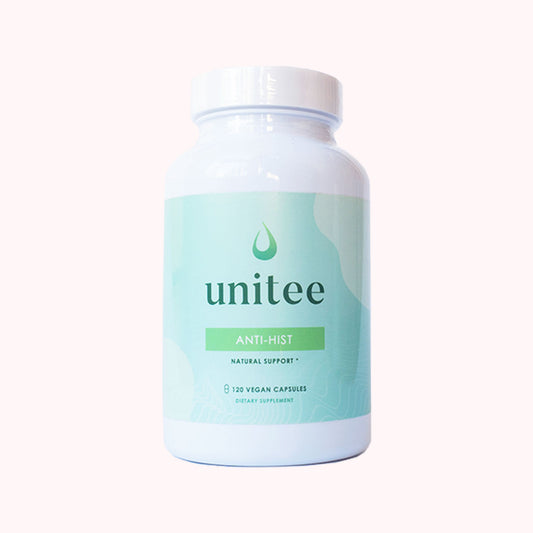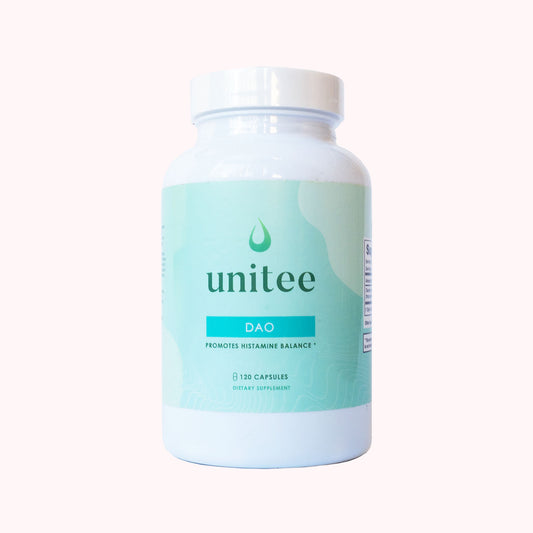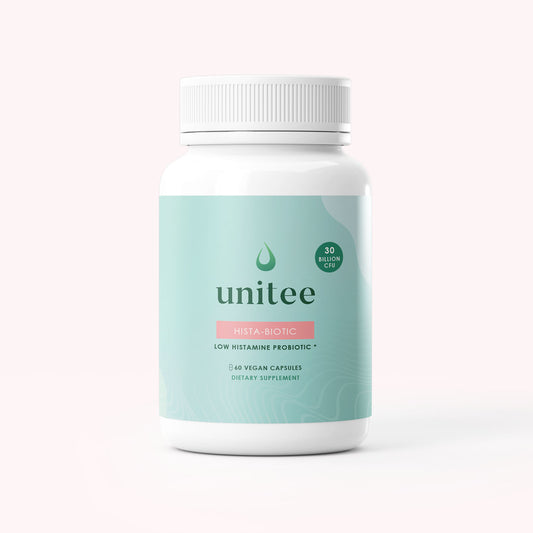Have you ever wondered if there's a link between exercise and histamine intolerance?
Whether exercise can reduce histamine levels? Or whether your symptoms get worse through exercise induced histamine release?
You may have also considered where you draw the line between pushing through body-healing exercise or calling it quits to prevent irritating your histamine intolerance.
Well, now we have some answers for you...
In as early as 1935, researchers showed that exercise and histamine levels share a close connection. In an animal study, the rise in histamine levels during exercise correlated with the intensity and duration of the exercise being performed [1].
While this early research was performed in animals, decades later, research confirms the same effect can be witnessed in humans…
You likely don’t need the research to tell you that there's a connection. Because, you’re living it.
What Is Exercise Induced Histamine Release?
Check any forum discussing exercise and histamine and you’re likely to see some very negative comments. So many people appear to be "allergic" to exercise, just like you!
Like them, every time you try to exercise, your heart rate goes up, your limbs go numb, a rash develops across your body, you feel dizzy or develop a migraine-like headache either during or following exercise.
It’s these reactions that are likely to leave you thinking that exercise is just not a good idea for you. Much like avoiding animal hair if you’re allergic to it, you might as well accept the fact that you’re never going to be fit if you live with histamine intolerance.
But the real question is: should you just concede and accept it?
The answer might surprise you!
Why Exercise Doesn’t Have to Worsen Your Symptoms of Histamine Intolerance
I agree that it's definitely not good for your health to push through exercise that makes you feel sick or could potentially push you into feeling like you could go into anaphylaxis at any minute. But, exercise is an important part of your histamine intolerance management plan; and when it comes to exercise and histamine, it’s the type of exercise you choose to do that has the greatest impact.
In addition to choosing the right type of exercise, the key to really managing your symptoms of histamine intolerance is to ensure that you're on a low histamine diet. Many of the foods on the list also utilizes foods which act as mast cell stabilizers.
If you haven't begun a low histamine diet or are unsure if your current diet is comprehensive, click below to download my free guide to histamine intolerance, which also explains 4 secret strategies for reducing histamine intolerance symptoms.
When utilizing the correct diet, choosing the right type of exercise will not only have a profoundly positive effect on your body’s histamine release but, it will also have a beneficial effect on your symptoms overall. Particularly your energy levels and fatigue, which can play a major role in whether you're able to continue to include exercise in your routine on your way to overcoming your symptoms of histamine intolerance.
Before we get into the ‘right’ types of exercise that you can include going forward, let’s look at the elements to consider when addressing exercise and histamine.
What’s the Connection Between Exercise and Histamine Intolerance?
When it comes to exercise and histamine intolerance, there are a number of reasons that you could be experiencing those histamine reactions in the first place.
Let's get into two of the most common reasons.
Reason 1: Excess histamine release
Typically, histamine is released when your body experiences an invasion of a foreign protein.
Take, for example, a bee sting. The protein in the venom of the bee sting that enters the body causes the immune system to be triggered and histamine to be released. Histamine floods the area, which causes the area to swell and itch as the body stops the toxin from causing widespread harm.
This is what you probably know about histamine release, and might consider it's the same when it comes to histamine induced exercise intolerance. But research shows that exercise induced histamine release is not a result of the typical allergic reaction. Instead, it’s because of exercise-specific triggers that histamine is released [2], and how these triggers activate specific histamine receptors.
There are 4 types of histamine receptors, namely H1, H2, H3 and H4.
Skeletal muscles are one of the tissues within the body that contain a wide distribution of the specific H1 and H2 type of histamine receptors [3]. Skeletal muscles also contain a wide distribution of mast cells. Because skeletal muscle is prone to damage, through exercise for example, they need these mast cells to stimulate the processes related to tissue repair. But it's this that causes the histamine reaction you're now likely so familiar with feeling.
When you exercise, micro damage is caused within the muscle, the mast cells, embedded within the skeletal muscle, release their contents of histamine, which binds to these receptors, eliciting a histamine response [4].
You read that right!
It is absolutely normal for mast cells to be activated due to an increase in inflammation within the muscles as a result of exercise.
In every person, high intensity exercises – and, in fact, even moderate intensity exercise in more sensitive people – causes tiny tears in muscle fibres, which trigger a mast cell response and, therefore, provoke exercise induced histamine release [5].
For most people, however, this is not an issue. Sure, most people experience a little pain and inflammation, but their heart rate doesn't shoot up, they don't go itchy all over and they don't feel absolutely awful for hours or days following the activity. For you, however, it's this relationship between exercise and histamine that you suffer the way you do when you take part in physical activity.
This relationship is also responsible for some of the symptoms you may not even realize are part of the histamine reaction. Systemic symptoms such as low blood pressure, which often follows exercise due to the vasodilation it causes (relaxation of the blood vessels and subsequent reduction in the pressure exerted by the blood flowing to essential organs).
It’s also one of the most common reasons for dizziness and weakness following exercise, even in healthy young adults [6]; but, in those with histamine intolerance it’s even more severe, can last longer, and may also be associated with panic and anxiety when it comes to exercise.
When the above is considered, it may appear that you really are allergic to working out and that as a means to regulate histamine overload, exercise may seem counterintuitive.
But the truth is, it really is an important part of your recovery and management of your condition.
The key is finding an exercise routine that works for you, that allows you to build up your ability to take part in more physical activity and, that benefits your health and wellbeing overall.
As you'll find out as you keep reading, it’s not about hitting the streets and training to run a marathon and you don’t have to jump into an intense step class to get the benefits of working out… you don’t even have to take up kickboxing or CrossFit, either.
Something far more gentle and calming, but still involving some form of activity, can be just what you need to keep moving without it resulting in a surge in histamine.
More on that in a bit. Let's get into the second most common reason you may be struggling with histamine induced exercise intolerance.
Reason 2: High histamine workout equipment
It's often overlooked that some of the equipment we use during our workouts contains histamine-releasing or histamine-containing compounds.
Unfortunately, there are a large number of pieces of workout equipment that are made of some of the cheapest plastics, PVC and neon colorants. Considering this, you might start to get an idea of how these materials and dyes can irritate our systems, triggering your histamine symptoms by aggravating your immune system.
The number 1 culprit for these materials is yoga mats or exercise mats. Those $20 bright pink mats that are an absolute bargain could actually be seriously damaging your health in the long run.
Another common culprit is dumbbells. There certainly is a big difference between the ones that are made from cast iron or stainless steel and the plastic coated ones. It's best to opt for the formed and avoid the latter, and the coated dumbbells typically use cheap dyed rubbers, which may trigger your histamine intolerance symptoms.
But we strongly suggest, that if you're going to swap out one piece of equipment you suspect is irritating your symptoms, it should be the mat you work out on.
Getting a high quality yoga mat made of natural materials to do anything from yoga to core exercises, stretching and pilates on can make a huge difference.
The mat I personally use is this Yoco cork yoga mat. It's all-natural, hypoallergenic and antibacterial, which makes it great for those who are histamine intolerant.
How to Make Working Out Work for You When You Have Histamine Intolerance
From what you've read above, it might be predictable that one of the recommendations I'll give for working out is to find exercises that aren't pushing you to your absolute limits and are more gentle on your healing body.
Yoga
One of the exercises that comes up regularly is yoga, but it also depends on the type of yoga you choose. We're all at different fitness levels - some may find they are able to dive right into an hour of vinyasa flow yoga without too much difficulty, while others may not be able to tolerate even one strength movement.
Fortunately, with so many varieties available, you can tailor your yoga session to suit your needs, even choosing an alternative depending on how you feel from one day to the next.
One of the other great benefits of yoga is the target on mental health. Stress – which can also be a reason the intensity of exercise sends you into a histamine-induced downward spiral – causes mast cells to become activated and may increase histamine release as a response to inflammation.
Likewise, even the stress that comes about when you think about exercise can cause histamine to increase!
Yoga can have a calming effect on the body and mind as it focuses on breathing and relaxation. Yoga apps are plentiful, and can set you up to do calming yoga sessions in the comfort of your own home.
Once again, do not use a mat that is made from synthetic materials, PVC or anything that's neon - it's likely going to irritate your symptoms. Go for an all-natural, high quality, low histamine yoga mat that's going to leave you feeling refreshed and symptom-free.
Walking
Walking is another great way to exercise without suffering the histamine-related consequences. The Physical Activity Guidelines, as suggested by the Centres for Disease Control and Prevention, encourages adults to take part in at least 150 minutes of moderate intensity exercise every week, and walking can easily make up this time with 30 minutes on most days of the week.
Strength
Strength exercises are another important part of physical activity. While lifting weights can place a significant amount of strain on your muscles and cause higher degrees of muscle damage as a means to build them bigger and stronger, you don’t have to take part weightlifting that gets you a ticket to the Olympics for it to be beneficial. Lighter weights, lower reps and routines with a low-moderate intensity are still great for your body, particularly when you have issues with your histamine load.
One of my favourite workout websites is called Fitness Blender. I've personally used them for nearly a decade, so I'm a huge fan of their hundreds of free workout videos of all types (including yoga, strength, and low impact cardio).
Don’t Be Afraid of Exercising When You Have Histamine Intolerance
Exercise may be intimidating, as you've likely experienced severe reactions to it in the past. But, when you try again, take it slow in the beginning and schedule in an appropriate number of days rest in between exercise days.
Because histamine release is associated with Delayed Onset Muscle Soreness (DOMS), allowing the muscles to recover almost fully before the next workout can reduce the surge of inflammation and histamine release at the next training session [7].
As your muscles begin to become accustomed to the exercises and physical exertion, your intensity can increase, and rest periods decrease.
Whatever you decide, make it work for you. Take a serious look at your goals, and consider how you will achieve them while still managing the histamine-induced turmoil that has taken over your body for the time being.
Don’t push too hard, or too fast! Managing exercise and histamine intolerance is a long-term goal, and finding the ‘perfect’ routine may take time… but when you do, it’ll certainly be worth it.
There are other points to consider when taking part in exercise when you have a histamine intolerance.
4 Ways to Reduce a Histamine Response During Exercise
Food can have a huge impact on exercise and histamine [8]. And these four food-based considerations can have a positive effect on whether exercise brings about a surge of histamine.
- Change when you eat. Eating right before exercise can be a problem for some people. One reason could be because food may trigger increased release of histamine from the gut bacteria, which can then push histamine load. Rather eat an hour or two beforehand, and take the next point into account.
- Choose what you eat wisely. Food may not only cause histamine release from your body, but, may itself be a histamine liberator - although, mast cell stabilizing supplements such as Anti-Hist can help to reduce this histamine liberation. It’s important to take this into consideration, especially on training days. Most of all, be sure you're eating foods that are low in histamine and that reduce histamine load. Download the full food list below to start eating properly!
- Think about what you’re fuelling with. Energy bars, whey protein shakes and protein bars may be the reason you’re having difficulties with exercise and histamine. If you’re looking for a protein source, choose eggs, for example, over processed ‘health food’. Or, try my recipe for a Low Histamine Superfood Smoothie
- Come up with a formula. On training days, it may be easier to eat the same diet for that day, that you eat on every other training day. While it’s important to have a variety of nutrients and dietary diversity for health and wellbeing, if exercise and histamine are a problem, the days you do train can be quite formulaic as long as the other days are more nutrient rich.
Sometimes, you may come across information that may be less helpful. For example, using antihistamines during exercise.
But, let's dive into why that may not be such a great idea...
Why Antihistamines Before Exercise May Not Be the Answer
Research conducted by the University of Oregon in 2016 provided evidence to support the case against the use of antihistamines in exercise-induced histamine responses. The reason this isn't the best idea is because part of the recovery process of exercise is carried out by mast cells and subsequent histamine release [9].
Along with the relaxation of blood vessels, an increase in blood flow contributed to the histamine response which, as a result of skeletal muscle exercise, lasted as long as two hours. The researchers concluded that, while histamine may have seriously negative connotations attached to it, the importance of its release during exercise recovery cannot be overlooked [9,10,11].
If you are currently taking antihistamines to manage histamine release during exercise, speak to your doctor about alternatives before simply stopping any medication you have been prescribed.
Exercise induced histamine release is often as a result of a combination of histamine increasing factors. As someone who has histamine intolerance or is struggling with histamine overload, a better way to reduce the release of histamine – or its effects - during and after exercise, is to manage your levels altogether, such as through diet and lifestyle changes.
References:
- Magnum, J., et al. The effect of local passive heating on skeletal muscle histamine concentration: implications for exercise-induced histamine release. Journal of Applied Physiology 2022 132:2, 367-374
- Luttrell MJ, Halliwill JR. The Intriguing Role of Histamine in Exercise Responses. Exerc Sport Sci Rev. 2017;45(1):16-23. doi:10.1249/JES.0000000000000093
- Pellinger TK, Dumke BR, Halliwill JR. Effect of H1- and H2-histamine receptor blockade on postexercise insulin sensitivity. Physiol Rep. 2013;1(2):e00033. doi:10.1002/phy2.33
- Halliwill JR, Buck TM, Lacewell AN, Romero SA. Postexercise hypotension and sustained postexercise vasodilatation: what happens after we exercise? Exp Physiol. 2013 Jan; 98(1):7-18.
-
Ayada K, Watanabe M, Endo Y. Elevation of histidine decarboxylase activity in skeletal muscles and stomach in mice by stress and exercise. Am J Physiol Regul Integr Comp Physiol. 2000;279(6):R2042-R2047. doi:10.1152/ajpregu.2000.279.6.R2042
- Barrett-O'Keefe Z, Kaplon RE, Halliwill JR. Sustained postexercise vasodilatation and histamine receptor activation following small muscle-mass exercise in humans. Exp Physiol. 2013;98(1):268-277. doi:10.1113/expphysiol.2012.066605
- Ely MR, Romero SA, Sieck DC, Mangum JE, Luttrell MJ, Halliwill JR. A single dose of histamine-receptor antagonists before downhill running alters markers of muscle damage and delayed-onset muscle soreness. J Appl Physiol (1985). 2017;122(3):631-641. doi:10.1152/japplphysiol.00518.2016
- Barg W, Wolanczyk-Medrala A, Obojski A, Wytrychowski K, Panaszek B, Medrala W. Food-dependent exercise-induced anaphylaxis: possible impact of increased basophil histamine releasability in hyperosmolar conditions. J Investig Allergol Clin Immunol. 2008;18(4):312-315.
- Emhoff CA, Barrett-O'Keefe Z, Padgett RC, Hawn JA, Halliwill JR. Histamine-receptor blockade reduces blood flow but not muscle glucose uptake during postexercise recovery in humans. Exp Physiol. 2011;96(7):664-673. doi:10.1113/expphysiol.2010.056150
- Romero SA, Hocker AD, Mangum JE, et al. Evidence of a broad histamine footprint on the human exercise transcriptome. J Physiol. 2016;594(17):5009-5023. doi:10.1113/JP272177
- Niijima-Yaoita F, Tsuchiya M, Ohtsu H, et al. Roles of histamine in exercise-induced fatigue: favouring endurance and protecting against exhaustion. Biol Pharm Bull. 2012;35(1):91-97. doi:10.1248/bpb.35.91

Anita Tee
My name is Anita Tee. I'm a nutritional scientist who specializes in histamine intolerance. I hold a Master of Science in Personalized Nutrition and a Bachelor of Science in Human Biology and Psychology. For the past ten years, I have used my experience in nutritional and medical health sciences to create a scientifically backed, natural approach to healthcare that relies 100% on evidence-based research. As I previously suffered from - and overcame - histamine intolerance, my focus is to increase recognition and expand the available resources and protocols available for resolving this particular disorder. To date, I have helped over 4,000 individuals fully resolve or better manage their histamine intolerance symptoms.







